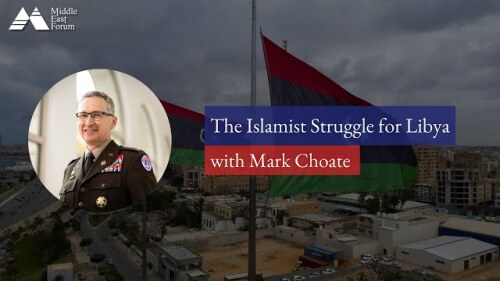Adi Schwartz, research fellow at the Misgav Institute and post-doctoral fellow at the Ben-Gurion University of the Negev, spoke to a November 13 Middle East Forum Webinar (video). The following summarizes his comments:
Historically, the Arab-Israeli conflict can be separated into two periods: before and after Israel’s 1973 Yom Kippur War. The 1948, 1967, and 1973 wars were each fought to thwart an “existential threat” to Israel’s territory and survival. In each instance, the Arab attempt to destroy Israel via conventional warfare failed.
As no major war had occurred since 1973, leading historians believed that bordering Arab states Egypt and Jordan had “had enough” and signed peace agreements. Still, hostile intentions toward Israel remained “in some of these circles,” and Israel continued to absorb terror attacks. Although the Jewish state still faced repeated diplomatic attacks and “attempts at delegitimization,” the general mindset had been that the “existential territorial threat” of invasion was relegated to history.
Hamas’s infiltration from the Gaza Strip into southern Israel on October 7th dispelled that assumption and began a new phase. In a multi-pronged assault, the terror group “succeeded in actually invading into the territory of the state of Israel, occupying even for a few hours, villages, communities, cities, committing atrocities.” Hamas’s barbaric atrocities against the largely civilian Jewish population in southern Israel resulted in a single-day death and casualty toll not seen since the Holocaust. These attacks, as well as the launching of missiles from Hezbollah on communities along the northern border with Lebanon, have resulted in the dislocation of “two hundred thousand refugees inside Israel.”
The attack was a result of the “convergence of two separate trajectories, separate axes” that threaten Israel: the Palestinian Sunni Arab axis, and the Iranian Shiite axis. Together, they represent an existential threat to Israel. The Shiite threat is from Hezbollah in the north, Iran-backed militias from Syria and Iraq, and Houthi rebels in Yemen who launch long-range missiles aimed at Israel. The Sunni threat is from Hamas in the Gaza Strip and the restive population of Palestinian Arabs in Judea and Samaria, aka the West Bank.
Israel, tasked with securing its people and land, faces two issues: the enemy’s motivation to act on its intentions, and the enemy’s means to do so.
The Palestinian Arab motivation is that “Israel should not exist.” Since the Jewish state’s re-establishment in 1948, a “simplistic narrative” fuels the Palestinian Arab cause through the present day: “They are the complete victims; their lands were stolen by the Jews in 1948; the Jews had no excuse to do that.” The narrative has been consistent since its origins and has similarly been repeated by the Arabs through “the forties and fifties.” It remains unchanged.
Technological and economic developments since 1948 have not changed the narrative peddled by Hamas, a branch of the Muslim Brotherhood, or by Fatah, which controls the Palestine Liberation Organization (PLO) and the Palestinian Authority (PA). Differences in their vision of what will replace Israel aside, their shared view of Jews includes eliminating the Jewish state, relegating the Jews to a “minority under Muslim rule,” and the unfettered ability to commit any atrocity against them.
Hamas’s mutilation of the bodies of the Jews slaughtered on October 7th follows a pattern of atrocities in Palestinian Arab attacks throughout Israel’s history. An early example of this was the murder and mutilation of the bodies of the eleven Israeli athletes by PLO terrorists at the Munich Olympics in 1972.
Although the Palestinian Arabs’ virulent hatred of Jews that permeates its education and society has been compared to that of Nazi Germany, there are differences. Germany “somewhat” functioned as a democracy in the twenties and early thirties before the rise of Nazism. There were also dissident voices as the Nazis came to power. After the Allies defeated the Nazis, the process of denazification, albeit incomplete, found those who were not Nazi sympathizers taking part in Germany’s reconstruction under Allied supervision.
In contrast, there are no Palestinian Arab political leaders or dissident voices condemning Hamas’s cause to destroy Israel and kill all Jews. To the contrary, Hamas is cast as “liberators” among its supporters and sympathizers and its savagery is celebrated. Excuses made for the absence of any Gazan dissident who would be silenced under the Hamas dictatorship does not account for the Palestinian Arabs in the diaspora who have the freedom to object but choose not to.
There are no Palestinian Arab political leaders or dissident voices condemning Hamas’s cause to destroy Israel and kill all Jews. Hamas is cast as “liberators” among its supporters and sympathizers.
The amount of support for the October 7th attack from “simple people in the street” to the “so-called moderate PA” ministers is evidence that it is only “a question of the means or the ability” that a similar attack would be launched against the Jewish inhabitants of Judea and Samaria. Hamas represents a majority of the Palestinian Arab people in the West Bank as well as in Gaza, which belies pronouncements from President Biden, who has been supportive of Israel in his comments, but whose assertion that “Hamas does not represent the Palestinian people” is “simply not true.”
Had elections been held among the West Bank Arabs prior to October 7th, “more than fifty percent” would have voted for Hamas. Despite the improved living conditions in their areas when compared to the poverty and isolation Hamas has inflicted upon Gazan residents, West Bank Arabs prefer Hamas. Among the thousands of infiltrators from Gaza on October 7th were its citizens, young and old, who eagerly participated in the looting, maiming, and torture of the residents of kibbutzim in southern Israel. As Israel wages its war against Hamas, it is engaged in efforts to locate and recover the more than two hundred hostages now languishing in Gaza.
Populations in the surrounding Arab countries of Egypt and Jordan are comprised of “hardcore antisemites” who are anti-Israel despite both countries’ peace treaties with Israel. However, there are distinctions between the people and their “pragmatic” leaders. Egyptian President al-Sisi and Jordan’s King Abdullah II have no love loss for the Muslim Brotherhood, which has been a threat to their rule. Both Al-Sisi and Abdullah want Israel “to dismantle and kill Hamas.”
Most states at the recent emergency Arab Summit in Riyadh called by the Arab League and the Organization of Islamic Cooperation (OIC) were in favor of punitive measures against Israel. In a “positive” sign, nine “blocked some of the harsher resolutions against Israel.” Among them were Egypt and Jordan, as well as the moderate Gulf states that are current or likely Abraham Accord partners: the United Arab Emirates (UAE), Saudi Arabia, and Bahrain.
The hostility that has spread globally against Israel since Hamas’s October 7th attack is evident in international venues such as the UN, with its biased agenda against Israel, and on American university campuses, where administrators are largely cowed and remained silent when faced with aggressive anti-Israel and antisemitic campus groups. Accompanying a global rise in antisemitic attacks are increasingly vociferous anti-Israel and antisemitic chants heard in mass demonstrations across Europe and the West. Yet, what is necessary to sustain momentum to win Israel’s war against Hamas is the continued “resilience” of the entire Israeli population, “from the prime minister to the last soldier and to the last citizen.”
There should be “no heavy weapons, no Hamas in the Gaza Strip, no Hamas in the West Bank, no Palestinian Authority in the sense that they cannot have heavy armory or automatic guns.”
While Israel prosecutes its war against Hamas, it has to “tactically decide” its day-to-day operations in Gaza. As Israel is not a “superpower,” it is cognizant of its limitations in its conduct of a war. It has gone “above and beyond” to “pacify” humanitarian demands from the West by distinguishing between Gazan civilians and Hamas. Taking steps in order to sustain goodwill, particularly from the U.S., it is still impossible for Israel to know “what ‘non-combatant’ or ‘civilian’ means in the Palestinian context,” given the participation of a multitude of Gazans in Hamas’s October 7th attack.
The challenge of confronting this threat is not Israel’s alone. The Middle East and the entire world will have to contend with an Arab population taught from inception that they are victims and that taking any means necessary to “address this injustice” is justified. When the “national narrative” voiced by Palestinian Arabs “rejects the notion of the state of Israel,” the threat posed by Palestinian Arabs must first be physically destroyed. The medium- and long-range remedy to the “maximalist vision” of destroying Israel is twofold: Demilitarize and denazify/deradicalize.
“Demilitarizing the entire area” is the removal of all means that the Palestinians use to kill Jews or harm the state of Israel. There should be “no heavy weapons, no Hamas in the Gaza Strip, no Hamas in the West Bank, no Palestinian Authority in the sense that they cannot have heavy armory or automatic guns.” The “entire area” refers to, “as they say, ‘from the river to the sea.’”
Denazifying the entrenched hatred will be a longer-term challenge which “Israel will not be able to do alone. It has to be a regional and international attempt to deradicalize the Palestinian society.” At this stage in the war, how the Gaza Strip and the West Bank will take shape is yet to be determined, but it is clear that the status quo ante is no longer acceptable. As the war unfolds, different scenarios as to how the war ends are of the utmost importance, and which scenario eventually plays out remains to be seen.





